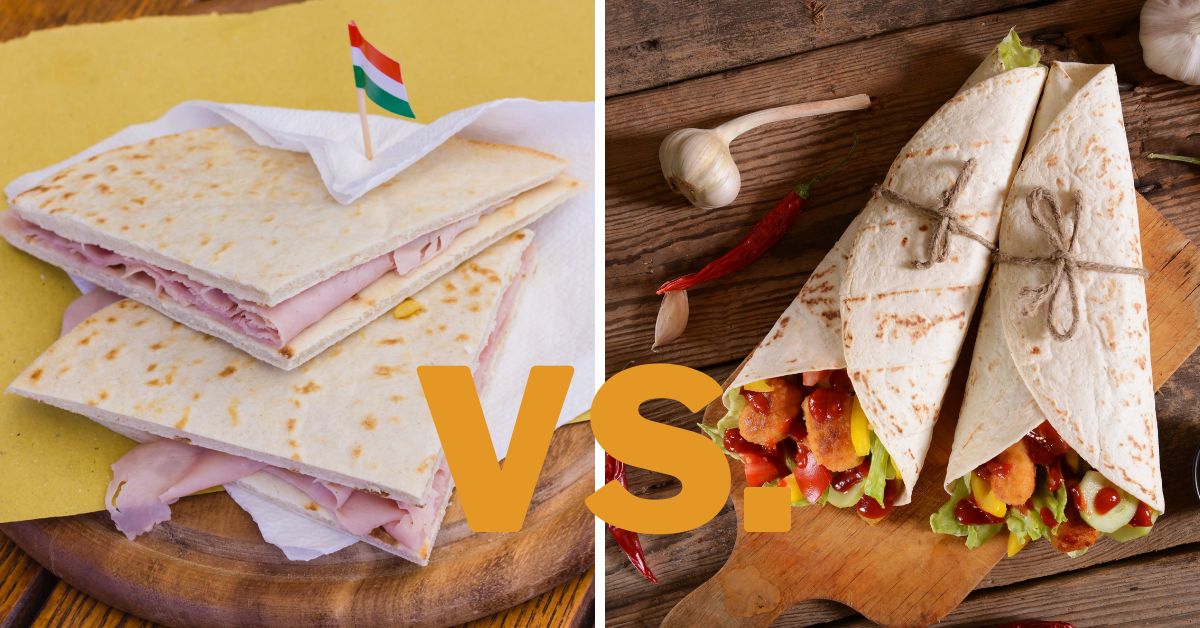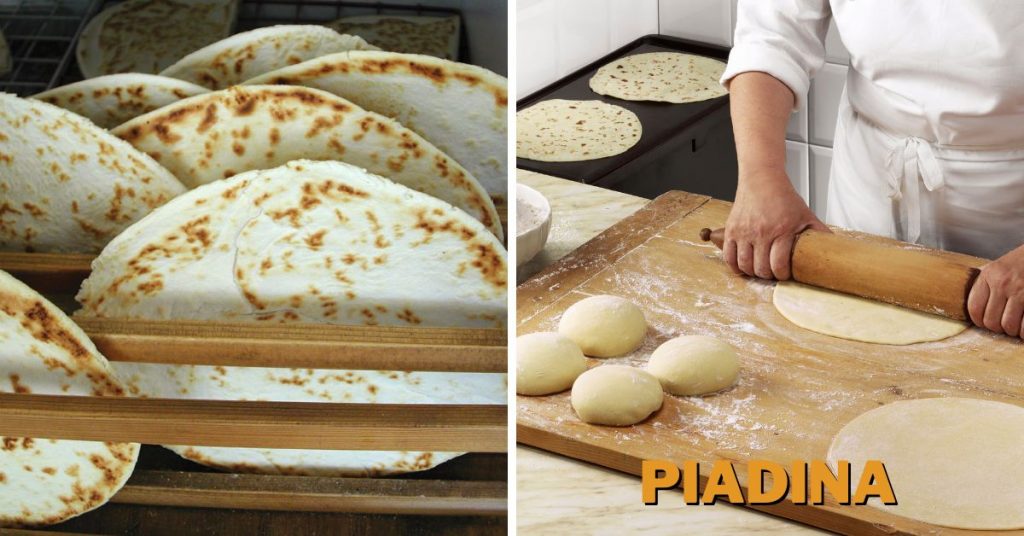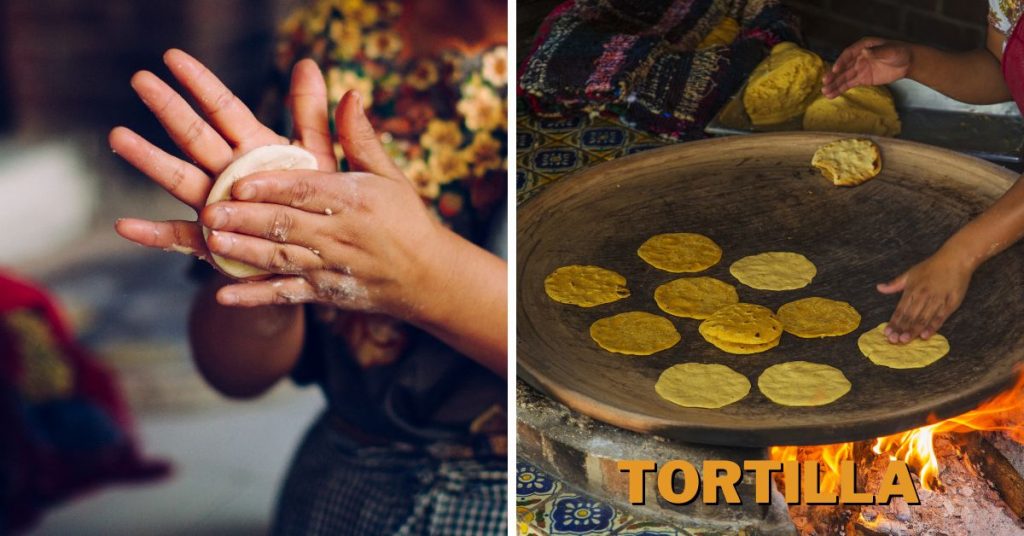Piadina vs. Tortilla: Differences & Uses

On the surface, a piadina and a tortilla share some resemblance. Both are folded in half to cover various fillings, forming a semilunar shape, made from bread mixture. But what are the differences between piadina and tortilla?
Piadina is an Italian flatbread, while tortillas are Mexican flatbread. Piadina is made from a mixture of flour, lard or olive oil, salt, and water. In contrast, tortillas can be made with (flour tortillas) or without (corn tortillas) fat. The addition of fat gives piadina a crumblier texture.
In this article, we will discuss the origins of these foods, their preparation, ingredients, uses, and nutritional value.
Piadina vs. Tortilla: Differences
Before we start, take a look at a cheat sheet.
| Features | Piadina | Tortilla |
|---|---|---|
| Size | 8-10 inches | 4-6 inches |
| Origin | Italy | Mexico |
| Popularity | Relatively less popular | More widespread |
| Use | As a wrap for various fillings | Various dishes like acos, burritos, quesadillas, tostadas, etc. |
Origin
Piadina
Piadina hails from the same place where most pizza dishes originate – Italy. Specifically, the region of Romagna first popularized this type of flatbread, which spread to other parts of the nation. Compared to tortillas, piadina is a much more recent invention.
Tortillas
The roots of tortillas go back thousands of years to prehistoric times. Corn tortillas, in particular, became one of the staple foods for North American and Mesoamerican during that period.
Flour tortillas, in contrast, are a more recent invention. This is because corn was the agricultural crop of choice in ancient Mexico. Only after European colonization did cultivate wheat become common in these parts of the world. This type of tortilla initially originated in Northern Mexico before spreading to other parts of the region.
Ingredients
Piadina
Piadina consists of the basic bread ingredients – flour, salt, and water. But there is an additional element that is key to its taste and texture – fat. Typically, this fat is in the form of lard or olive oil. Compared to most flatbreads, this fat gives piadina a richer flavor.
Tortilla
There are mainly two types of tortillas, and the key difference between them is the ingredients. Corn tortillas, which is the original tortilla, are made from hominy, salt, and water. Hominy is dried corn kernels that have been treated with lime water. This initiates a process called Nixtamalization, which greatly improves the texture and nutritional value of the corn.
Flour tortillas or wheat flour tortillas use flour instead of corn. Similar to piadina, flour tortillas frequently utilize lard or vegetable oil but not always. The use of baking powder or some sort of leavening agent is also very commonplace, which is not the case for piadina.
Preparation
Piadina
Traditionally, piadina was cooked in a hot terracotta dish. But they are typically made using cast-iron skillets or similar flat griddles nowadays. First, you combine the requisite amount of flour, salt, and optional baking powder. Then you slowly combine olive oil or lard and water. You can also add milk for a creamier taste.
Next, you need to knead the dough until it is not sticking to the sides of a bowl. You can always add more flour or water to get your desired consistency. Then you cover and let the dough rest for at least 30 minutes.
Afterward, you roll the dough on a lightly floured surface until it is ⅙ or ⅛ inches thick. The thickness will depend on your preference. Finally, you cook the flat dough on a flat, lightly oiled skillet over medium-high heat. You normally cook one side of the bread until bubbles start forming and it turns a golden brown color.

Tortillas
Corn tortillas are made from specially treated maize or “masa”. The corn kernels are dried and cured in lime water. This causes the skin of the kernels to peel off. This corn is then ground, cooked, and kneaded into dough. The dough is flattened with a rolling pin or tortilla press and cooked in a corneal, which is a type of griddle popular in Mexico.
Flour tortillas are much simpler. There is no process involving lime water here. You mix wheat flour, salt, and water and knead it into a dough. Then you press the dough and cook it like a corn tortilla.

Uses
Piadina is used as a container for various fillings, forming a semi-circular sandwich. The fillings are typically some combination of meat, cheese, and vegetables. Instead of ground meat, piadina usually incorporates cured meat such as prosciutto and salami. It uses mozzarella and ricotta most commonly.
Tortillas are used in a wide variety of dishes such as tacos, burritos, fajitas, quesadillas, enchiladas, chimichangas, tostadas, etc. The tortilla can be folded half as a taco or quesadilla, used as a wrap like burritos and chimichangas, or lay flat as tostadas.
Nutrition
For this comparison, we are going to look at the nutritional data for 100 grams each of piadina, flour tortilla, and corn tortilla [1] [2] [3]:
| Nutrition | Piadina | Flour Tortilla | Corn Tortilla |
|---|---|---|---|
| Energy | 464 kcal | 306 kcal | 218 mg |
| Carbohydrate | 53.6 g | 49.4 g | 44.6 g |
| Dietary Fiber | 3.6 g | 3.5 g | 6.3 g |
| Protein | 3.57 g | 8.2 g | 5.7 g |
| Iron | 1.29 mg | 3.63 mg | 1.23 mg |
| Sodium | 571 mg | 736 mg | 45 mg |
| Niacin | negligible | 4.42 mg | 1.5 mg |
Sizes
Typically, corn tortillas are 4 to 6 inches. They rarely get any larger as the tortilla is likely to crumble if it does. Flour tortillas can get much bigger, up to 12 inches. In most cases, however, these tortillas are about 6 to 8 inches.
A typical piadina is about 8 to 10 inches wide and about 0.2 inches thick. So, piadina is usually larger than a regular taco.
Popularity
In terms of popularity and distribution, tortillas are much more common in regions around the world than piadina. Dishes like tacos, quesadillas, burritos, etc., are popular street food items in many cuisines. In contrast, piadina is much more niche.
Variations
Tortillas have two main variations – corn tortillas, made from masa harina, and flour tortillas, made from wheat flour.
Piadina does not have such significant variations. They include flour, salt, water, and some form of fat.
Piadina vs. Quesadilla: Are They the Same?
Piadina and quesadilla are two prominent dishes from different cuisines. Piadina is a semi-circular flatbread sandwich with various fillings popular in Italy. Quesadillas are a staple of Mexican cuisine, and they use tortillas as their base.
What Does La Piadina Mean in Italian?
La piadina translates to “the piadina”, which is a phrase to indicate a piadina-based dish.
Can You Eat Piadina and Tortilla Without Heating Them?
If the piadina and tortilla come pre-cooked, you can safely eat them without heating them. The bread will not be raw in this case. Similarly, if you have already cooked the bread before filling it with anything, they are safe for consumption.
To conclude, both piadina and tortilla are flexible, versatile flatbreads. You can use them to wrap various combinations of ingredients.
